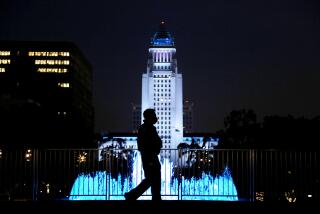Secessionists Dispute L.A. Study of Valley’s Revenues
- Share via
The San Fernando Valley has 35% of Los Angeles’ population, but produces just 31% of major tax revenues, according to an analysis released Friday that has potentially significant implications as the city confronts the prospect of secession.
Backers of Valley cityhood immediately challenged the report’s accuracy, which focuses on the 1998-99 fiscal year.
Several suggested that city officials may intentionally have underestimated revenues in a way that could sabotage secession efforts.
“The number is suspiciously low, but it doesn’t surprise me that Los Angeles would try to use this kind of tactic,” said Richard Close, chairman of the secession group Valley VOTE. “The city of Los Angeles does have incentive to give the Valley the fewest dollars it can.”
Secessionists say the critical comparison isn’t between revenue and population, but between the percentage of revenue and the percentage of expenditures. Secessionists in the Valley and the harbor area say they believe expenditures, when tallied next year, will be significantly below tax revenues generated by both areas.
The city study of 80 revenue sources has long been awaited by the Local Agency Formation Commission, the agency entrusted by state law with studying the financial impact of any secession. LAFCO has the power to place the secession question before voters.
In some categories, revenues from the Valley were far below 31% of the city total. That included hotel bed taxes (16%), parking ticket fines (13%) and parking taxes (8%).
LAFCO agency will independently check the city’s numbers and separately generate its own for a study to determine whether creation of Valley and harbor-area cities would cause financial harm to the rest of the city, officials said.
“It’s a key piece of information,” said Larry Calemine, executive director of LAFCO.
The other half of the equation--the percentage of city services and expenditures being provided in the Valley and the harbor area--will be addressed in a study scheduled to be released in March.
Lower-than-expected revenues could have both negative and positive effects on Valley and harbor secession proposals, observers say.
If revenues are less than the cost of services provided in the two areas, it could politically undermine the secessionists’ claims that they need to break away to get their fair share of services, said Councilwoman Laura Chick of Tarzana.
An underestimation of revenues also could help Valley secession. If the Valley generates more revenue than it gets back in services, secessionists say, that would mean the Valley is subsidizing services in other parts of the city.
LAFCO cannot put cityhood on the ballot unless it determines that separation would not harm the rest of the city. The agency might have difficulty, for instance, in approving secession for the ballot if the rest of the city would be forced to cut services because of a drop in revenue.
In such a case, one solution could be for the Valley to continue to subsidizing services in the rest of Los Angeles through a tax sharing agreement. But officials hope to avoid that sort of complex arrangement.
Secession would go more smoothly if revenues and expenditures in the Valley are about equal.
City Councilwoman Rita Walters, who opposes secession, said the report will help counter claims by secessionists that their areas have contributed more than their share of funds to the city without getting sufficient services in return.
“I certainly don’t believe that they are victims or that they ever have been victims,” Walters said.
Chick said those who, like her, want the city to stay together can use the results to make adjustments so that revenue and expenditures are better balanced for areas such as the Valley.
Chief Legislative Analyst Ron Deaton said the council-requested report is the best analysis of revenue that the city has.
“It is a snapshot of a single year and only evaluates why those areas produced those revenues that year,” the report said. “It does not attempt to determine potential future revenues and does not attempt to determine how pending decisions about the city would affect future revenues.”
Considering major revenue sources that can be easily broken out by geography--about 73% of total city revenues, or $3 billion--the report concludes that the Valley generated 31%, or about $956 million, the harbor area generated 3%, or about $90 million, and the rest of the city 66%.
About $869 million in license fees, permit fees and fines could not be broken down geographically.
The biggest sources of revenue were property taxes and utility user taxes, with each making up about 18% of the budget.
The Valley generated about 35% of the city’s property taxes, and the harbor area generated 3%, according to the study. At the same time, the Valley generated 35.6% of the utility users’ tax while the harbor produced 4%.
The Valley, with its shopping malls and car dealerships, made a strong showing in business retail taxes, generating 43% of the citywide total, and in sales taxes, of which it produced 42% of the city total.
The report, the first of its kind, shocked Andrew Mardesich, executive director of the Harbor Study Foundation, who disputed its finding that San Pedro and Wilmington generated only 3% of Los Angeles’ revenue, even though they have about 4% of the city’s population.
“I’m outraged,” Mardesich said. “Common sense and logic tell me that’s impossible.”
More to Read
Sign up for Essential California
The most important California stories and recommendations in your inbox every morning.
You may occasionally receive promotional content from the Los Angeles Times.














